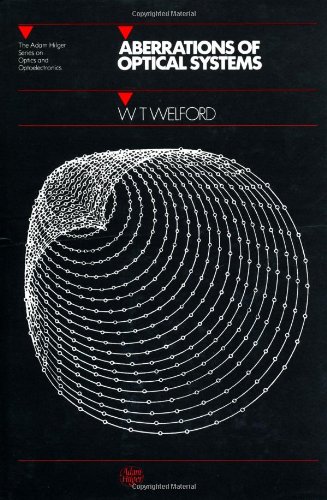W.T Welford0852745648, 9780852745649
Table of contents :
Contents……Page 4
Series Editors’ Preface……Page 8
Preface and acknowledgements……Page 10
1.1 Initial assumptions……Page 12
1.2 Ideal image formation in the symmetrical optical system……Page 13
1.3 Properties of an ideal system……Page 15
2.1 Rays and geometrical wavefronts……Page 21
2.2 Snell’s law of refraction……Page 23
2.3 Fermat’s principle……Page 26
2.4 The laws of geometrical optics……Page 28
3.1 The domain of Gaussian optics……Page 31
3.2 Definitions; the relationship between the two focal lengths……Page 34
3.3 The Lagrange invariant and the transverse magnification……Page 36
3.4 Afocal systems and star spaces……Page 39
3.5 The aperture stop and the principal ray……Page 41
3.7 Gaussian properties of a single surface……Page 44
3.8 Gaussian properties of two systems……Page 46
3.9 Thick lenses and combinations of thin lenses……Page 51
3.10 Paraxial ray tracing……Page 56
4.1 Finite rays……Page 61
4.2 Snell’s law for skew rays……Page 62
4.3 Transfer between spherical surfaces……Page 63
4.4 Refraction through a spherical surface……Page 65
4.5 Beginning and ending a raytrace……Page 66
4.6 Non-spherical surfaces……Page 68
4.7 Raytracing through quadrics of revolution……Page 70
4.8 The general aspheric surface……Page 72
4.9 Meridian rays by a trigonometrical method……Page 74
4.11 Failures and special cases……Page 76
5.1 Specification of toric surfaces……Page 78
5.2 The transfer process for a toric……Page 81
5.4 Raytracing through diffraction gratings……Page 82
5.5 Raytracing through holograms……Page 86
6.2 Alternative forms of the Lagrange invariant……Page 90
6.3 The Seidel difference formulae……Page 92
6.4 The skew invariant……Page 95
6.5 Some applications of the skew invariant……Page 97
6.6 The generalized Lagrange invariant……Page 98
7.1 Introduction: definitions of aberration……Page 103
7.2 Wavefront aberrations, transverse ray aberrations and characteristic functions……Page 104
7.3 The effect of a shift of the centre of the reference sphere on the aberrations……Page 109
7.4 Physical significance of the wavefront aberration……Page 110
7.5 Other methods of computing the wavefront aberration……Page 112
7.6 The theory of aberration types……Page 116
7.7 The Seidel aberrations……Page 120
7.8 Mixed and higher order aberrations……Page 139
8.1 Addition of aberration contributions……Page 141
8.2 Derivation of the Seidel aberration formulae……Page 142
8.3 Validity of the Seidel sum formulae……Page 152
8.4 Ray aberration expressions for the Seidel sums……Page 154
8.5 Computation of the Seidel sums; effect of stop shifts……Page 159
8.6 Aspheric surfaces……Page 163
8.7 Effect of change of conjugates on the primary aberrations……Page 164
8.8 Aplanatic surfaces and other aberration-free cases……Page 169
9.1 Introduction……Page 173
9.2 The Aldis theorem for transverse ray aberrations……Page 174
9.3 Expressions for total optical path aberration……Page 176
9.4 Aplanatism and isoplanatism……Page 182
9.5 Linear coma and offence against the sine condition……Page 183
9.6 Isoplanatism in non-symmetric systems……Page 187
9.7 Applications of the general isoplanatism theorem of Section 9.6……Page 192
9.8 Optics round a finite principal ray……Page 196
9.9 Astigmatism of quadrics of revolution……Page 201
10.1 Introduction: historical aspects……Page 203
10.2 Longitudinal chromatic aberration and the achromatic doublet……Page 204
10.3 Dispersion of optical materials……Page 206
10.4 Chromatic aberration for finite rays; the Conrady formula……Page 211
10.5 Expressions for the primary chromatic aberrations……Page 213
10.7 Ray aberration expressions for C and Cn……Page 217
10.8 Some examples……Page 218
11.1 Cylindrical systems……Page 221
11.2 Primary aberrations of anamorphic systems……Page 222
11.3 Aberrations of diffraction gratings……Page 225
11.4 Aberrations of holographic optical elements……Page 228
12.1 The thin lens variables……Page 237
12.2 Primary aberrations of a thin lens with the pupil at the lens……Page 239
12.3 Primary aberrations of a thin lens with remote stop……Page 243
12.4 Aberrations of plane parallel plates……Page 245
12.5 Some examples……Page 247
13.1 Design aberrations and manufacturing aberrations……Page 251
13.3 Tolerances for diffraction-limited systems……Page 252
13.4 Resolving power and resolution limits……Page 257
13.5 Tolerances for non-diffraction-limited systems; definition of the optical transfer function……Page 260
13.6 Formulae for the optical transfer function……Page 263
13.7 The OTF in the geometrical optics approximation……Page 268
13.8 Incoherently illuminated lines and edges as test objects……Page 269
13.9 Optical tolerances and image assessment……Page 270
Appendix A. Summary of the main formulae……Page 272
Appendix В. Symbols……Page 282
Appendix С. Examples……Page 284
Appendix D. Tracing Gaussian beams from lasers……Page 288
Name index……Page 290
Subject index……Page 292







Reviews
There are no reviews yet.